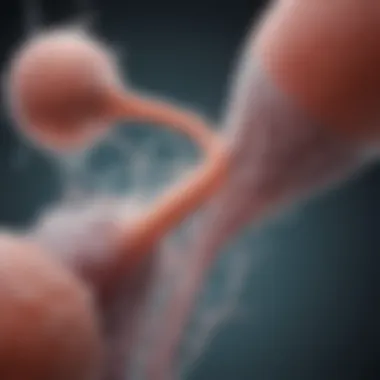Understanding Sperm Count and Semen: A Comprehensive Review


Intro
Understanding sperm count and semen quality is of fundamental importance in the realm of male reproductive health. As fertility issues become increasingly prominent in contemporary society, a comprehensive understanding of these concepts is essential. Not only do they affect individual choices around family planning, but they also reflect broader health trends and environmental impacts on reproductive systems.
Sperm production is a complex physiological process influenced by a variety of factors, including genetics, lifestyle, and environmental conditions. An informative exploration of sperm count provides insights into male fertility, its challenges, and its implications for reproductive health. This guide will dive deep into these topics, offering data-supported insights and well-researched information.
Research Overview
In order to understand sperm count and semen analysis effectively, reviewing current research findings and methodologies is crucial.
Key Findings
Recent studies have highlighted several important trends regarding sperm count:
- Decreasing Trends: Research indicates a significant decline in average sperm counts over the past few decades. Some studies suggest that sperm counts have dropped by nearly 50 to 60% in certain populations since the 1970s.
- Factors Affecting Sperm Quality: Environmental toxins, lifestyle choices such as smoking and excessive alcohol consumption, and obesity are identified as critical factors negatively affecting sperm production.
- Technological Advances: Advances in semen analysis techniques, such as computer-assisted semen analysis (CASA), have improved the accuracy and reliability of sperm assessments.
Study Methodology
Most contemporary research utilizes a combination of laboratory analyses and epidemiological studies. Researchers conduct sperm analyses in controlled conditions, often comparing samples from various groups to assess lifestyle impacts or health conditions. These studies apply rigorous statistical methods to ensure findings are valid and applicable across populations.
Background and Context
A historical perspective on sperm count can provide insights into its evolving significance in male reproductive health.
Historical Background
Historically, discussions around male fertility have often been overlooked. However, as societal norms shifted in the late 20th century, so did the acknowledgment of sperm count as a critical indicator of reproductive health. Literature began to surface that tied environmental changes and male health, paving the way for more focused studies.
Current Trends in the Field
Currently, there is a renewed interest in understanding the implications of diminished sperm counts on public health. Researchers and medical professionals are increasingly aware of the potential correlations between male fertility rates and reproductive health trends. This has led to a multidisciplinary approach involving endocrinologists, urologists, and environmental scientists.
Understanding sperm count is not just about individual health, but also a reflection of societal health as a whole.
"Sperm count is an indicator of men's overall health, and its decline raises questions about environmental and lifestyle factors affecting us all."
As more studies emerge, the conversation around sperm count and semen analysis will likely grow, leading to both public awareness and potentially impactful policy changes.
Preface to Sperm Count and Semen
Understanding sperm count and semen is pivotal in the broader context of male reproductive health. This topic is not solely academic but touches on significant aspects of human biology and reproduction. A thorough comprehension of these areas can reveal insights into fertility issues, contributing factors, and potential treatments. Additionally, sperm count serves as a fundamental indicator of male health. It reflects not only reproductive capability but also general well-being, linking to lifestyle choices and environmental factors.
Examining sperm production, its components, and associated factors brings clarity to complex biological processes. Addressing this subject holistically enables researchers, students, and healthcare providers to better grasp male fertility issues. The study of sperm count and semen extends beyond mere numbers; it emphasizes the importance of quality, health, and lifestyle in reproductive success.
This section articulates the foundational importance of sperm count and semen, setting the stage for deeper exploration into related physiological processes, influencing factors, and emerging methodologies in reproductive health.
Defining Sperm Count and Semen
Sperm count typically refers to the concentration of sperm in a given sample of semen. Measured in millions per milliliter, this figure is an essential parameter in assessing male fertility. A normal sperm count is usually above 15 million sperm per mL, as defined by the World Health Organization. Semen, on the other hand, is the fluid that carries sperm. It contains not just sperm cells but also seminal fluid, which nourishes and facilitates the motility of sperm.
The interplay between sperm count and semen quality is crucial. Most often, higher sperm concentration correlates with better fertility outcomes. However, factors such as sperm motility and morphology also significantly influence fertility. Therefore, understanding sperm count also involves examining semen composition and its biochemical environment to assess reproductive potential effectively.
Historical Context of Sperm Studies
The exploration of sperm count and semen has a long history, starting from ancient civilizations to modern scientific inquiries. Early thinkers, such as Aristotle, pondered the nature of reproduction, yet comprehensive studies began emerging in the 19th century. Researchers like Anton van Leeuwenhoek significantly advanced microscopy, enabling the observation of sperm cells for the first time.
As the centuries progressed, seminal research continued expanding our understanding of human reproduction. By the 20th century, advancements in medical technology and biochemical analysis allowed for more precise studies of sperm parameters and their implications. Significant collections of data established baseline measures of sperm health, influencing fertility treatments and lifestyle modifications.
Today, understanding sperm and semen has advanced, integrating disciplines such as genetics, endocrinology, and environmental science. This interdisciplinary approach has deepened our insights into the biological, environmental, and lifestyle factors that impact sperm count and overall reproductive health.
"The journey from ancient theories to modern science has shaped our understanding of sperm and fertility significantly."
In summation, sperm count and semen are not just parameters for fertility analysis; they encapsulate a complex interplay of biological and environmental factors that require detailed examination to improve reproductive health outcomes.
The Physiology of Sperm Production
The physiology of sperm production is a cornerstone of male reproductive health. Understanding this topic sheds light on how sperm cells are generated, their journey through the male reproductive system, and the hormonal regulation that governs these processes. This knowledge is crucial not only for those studying reproductive biology but also for individuals facing challenges related to fertility. By grasping the intricate workings of sperm production, one can appreciate the factors that influence male fertility and potential interventions for enhancing sperm count and quality.
Anatomy of the Male Reproductive System
The male reproductive system is a complex structure designed for the production and transport of sperm. It includes several essential components:
- Testes: These are the primary reproductive organs, responsible for producing sperm and hormones like testosterone.
- Epididymis: A coiled tube that stores and matures sperm after they leave the testes.
- Vas deferens: This duct transports sperm from the epididymis to the ejaculatory duct.
- Seminal vesicles and prostate gland: These glands produce seminal fluid, contributing to semen volume and providing nutrients for sperm.
Understanding this anatomy helps elucidate how sperm travel and the environments they navigate. Any dysfunction within these structures can lead to issues in sperm production and transport.
The Process of Spermatogenesis
Spermatogenesis is the process by which sperm are created. It occurs within the seminiferous tubules of the testes and involves several stages:


- Spermatogonia: These are the initial germ cells that undergo mitosis, producing primary spermatocytes.
- Meiosis: Primary spermatocytes undergo meiosis to form secondary spermatocytes, which eventually become spermatids.
- Spermiogenesis: In this final stage, spermatids mature into fully developed sperm cells, characterized by their flagellum and streamlined shape.
The entire process takes about 64 to 72 days in humans. However, sperm production is a continuous process, as spermatogenesis occurs in cycles within the testes.
Role of Hormones in Sperm Production
Hormones play a vital role in regulating sperm production. The key hormones involved include:
- Testosterone: Produced by Leydig cells in the testes, testosterone is essential for the development of male reproductive tissues and the stimulation of spermatogenesis.
- Luteinizing hormone (LH): This hormone stimulates testosterone production from Leydig cells.
- Follicle-stimulating hormone (FSH): FSH promotes the growth and maturation of sperm cells within the seminiferous tubules.
It is crucial to understand how hormonal imbalances can affect sperm production. Such imbalances can arise from various factors, including age, stress, or underlying health conditions.
Understanding the interplay of these hormones is fundamental for diagnosing and treating issues related to low sperm count.
In summary, the physiology of sperm production encompasses the anatomy of the male reproductive system, the detailed process of spermatogenesis, and the regulatory role of hormones. Each aspect contributes to a broader understanding of reproductive health and the factors that can influence fertility in males.
Factors Influencing Sperm Count
Understanding the factors influencing sperm count is essential in recognizing male reproductive health. This section outlines various determinants that can impact sperm production and overall fertility. Knowledge of these elements is not only valuable for individuals trying to conceive, but also for health professionals aiming to provide sound advice and interventions.
Genetic Factors
Genetic influences play a significant role in determining sperm count. Certain inherited conditions, such as Klinefelter syndrome, can lead to reduced sperm production. Additionally, variations in genes may affect hormone regulation, which is vital for sperm development. Research indicates that men with infertility often show a higher prevalence of genetic anomalies. Thus, understanding these genetic factors helps in grasping the underlying reasons for low sperm counts and can guide clinical decisions.
Environmental Influences
Environmental factors are critical in shaping sperm health. Men are frequently exposed to a variety of environmental toxins, such as heavy metals, pesticides, and endocrine disruptors. Studies demonstrate that prolonged exposure to these substances correlates with lowered sperm counts and increased abnormalities. It is important to consider the environments in which individuals live and work, recognizing that lifestyle and occupational exposure can have lasting effects on reproductive health.
Lifestyle Choices and Their Impact
Lifestyle choices significantly influence sperm production. Three key areas stand out: diet and nutrition, exercise and weight management, and substance use. Each element can help improve or negatively affect sperm quality in distinct ways.
Diet and Nutrition
Diet and nutrition are foundational to overall health and reproductive function. Nutritional deficiencies, particularly in antioxidants, vitamins, and minerals like zinc and selenium, can impair sperm production. A balanced diet rich in fruits, vegetables, whole grains, and lean proteins is considered beneficial for enhancing sperm count. It is a common belief that specific foods, such as walnuts or dark chocolate, may support fertility due to their nutrient content. Ensuring adequate intake of these nutrients can provide the body with the support needed for optimal sperm development.
Exercise and Weight Management
Exercise and weight management also play critical roles in maintaining healthy sperm counts. Regular physical activity can enhance circulation and hormonal balance, both of which are essential for sperm production. Obesity, on the other hand, is related to hormonal imbalances and decreased fertility. Therefore, integrating exercise into daily routines can serve as a practical approach to support reproductive health. Activities that promote cardiovascular health and maintaining a healthy weight are encouraged.
Substance Use and Abuse
Substance use and abuse encompass a broad range of behaviors that can negatively impact sperm health. Tobacco smoking, excessive alcohol consumption, and the use of illicit drugs are known to impair sperm quality and reduce counts. In particular, substances such as marijuana have been linked to lower sperm concentration and motility. Being informed about these risks is crucial for men seeking to enhance their fertility. Choosing to reduce or eliminate harmful substances can significantly improve reproductive outcomes.
Understanding Semen Analysis
Semen analysis is a vital component in the assessment of male reproductive health. It provides insights into key aspects that define fertility potential. Understanding this analysis helps in elucidating factors that contribute to sperm quality and function. Given that sperm count alone does not offer a complete picture, thorough examination of semen parameters is critical. This section highlights the primary elements assessed in semen quality and their significance in fertility concerns.
Parameters of Semen Quality
Semen quality is determined by several parameters. Each contributes uniquely to understanding reproductive potential. Monitoring these parameters allows for better insights into male fertility issues.
Volume
Volume refers to the total amount of semen produced per ejaculation. This parameter is essential because it often indicates the function of the male reproductive system. The average volume varies, but a typical ejaculation should consist of 1.5 to 5 milliliters. A volume below this range may raise concerns regarding seminal vesicle function or other underlying issues. A notable feature of volume is its direct relationship to the concentration of sperm. If volume is low with a normal sperm concentration, the total sperm count could still be sufficient but may be less effective in achieving fertilization.
Viscosity
Viscosity indicates the thickness or consistency of the semen. It plays a role in how sperm move through the female reproductive tract. Normal semen has a certain degree of viscosity, which facilitates sperm motility. However, high viscosity can impede sperm movement, potentially affecting fertility. This unique feature emphasizes the balance between viscoelasticity and fluidity in semen. Abnormally high or low viscosity can suggest potential issues that may need addressing.
Sperm Concentration
Sperm concentration measures the number of sperm present in a given volume of semen. This parameter is fundamental for evaluating fertility, as higher concentrations correspond with greater chances of successful fertilization. A typical count ranges from 15 million to over 200 million sperm per milliliter. The importance of sperm concentration cannot be overstated, as it directly correlates with overall male fertility. A low concentration can lead to diminished likelihood of conception. It is crucial to examine this parameter as part of an overall fertility evaluation.
The Semen Analysis Process
The semen analysis process involves several steps aimed at accurately assessing the various parameters of semen quality. Initially, the sample is collected either through masturbation or other medically approved methods. Following collection, the semen is allowed to liquefy, usually taking 20 to 30 minutes, before analysis. Laboratory technicians examine the sample using a microscope to evaluate volume, viscosity, sperm concentration, motility, and morphology.
Each parameter is analyzed methodically, and results are documented precisely. This approach assists healthcare professionals in making informed decisions regarding diagnosis and treatment plans. In summary, semen analysis serves as an essential diagnostic tool in the quest for understanding and improving male reproductive health.
Assessing Sperm Count and Fertility
Assessing sperm count and fertility is a fundamental aspect of reproductive health. The importance of this topic cannot be overstated, as it has direct implications for male fertility and the ability to conceive. Understanding sperm counts helps in diagnosing potential issues related to infertility. High sperm count, generally regarded as being above 15 million sperm per milliliter according to the World Health Organization, indicates better chances of successful fertilization. Conversely, low sperm counts are increasingly common and can present significant challenges for couples trying to conceive.
When evaluating sperm count, its quality also matters. Factors such as sperm motility, morphology, and overall semen health play a crucial role in determining fertility. Therefore, a comprehensive assessment of sperm count is essential for understanding male reproductive capability. This assessment helps identify potential medical conditions, environmental exposures, or lifestyle choices that may impact sperm quality.
Normal vs. Abnormal Sperm Counts
Normal sperm counts are indicative of a healthy male reproductive system. The accepted range for normal sperm concentration is between 15 million to over 200 million sperm per milliliter. Within this range, sperm motility and morphology also serve as predictors for fertility potential.


Abnormal sperm counts may categorize into two main conditions: oligospermia, where a male has fewer than 15 million sperm per milliliter, and azoospermia, where there is an absence of sperm entirely. The distinction between these conditions is crucial, as it affects the approach towards treatment and intervention.
Key differences between normal and abnormal sperm counts include:
- Sperm concentration: Higher in normal ranges.
- Sperm motility: Increased motility improves chances of reaching and fertilizing an egg.
- Sperm morphology: Normal parameters describe healthy sperm shape, which is essential for fertilization.
Consequences of Low Sperm Count
Low sperm count poses significant risks for male fertility. This condition can lead to difficulties in conceiving naturally, contributing to emotional stress for couples trying to start families. The implications extend beyond conception; low sperm count can indicate underlying health issues such as hormonal imbalances, genetic abnormalities, or infections.
The consequences of low sperm count may also include:
- Increased time to conceive: Lower sperm counts decrease the probability of reaching the egg.
- Lower likelihood of successful pregnancies: Associated with higher rates of miscarriage and complications.
- Association with other health problems: Low sperm count can correlate with cardiovascular diseases, metabolic syndrome, or hormonal imbalances, highlighting the need for a thorough medical evaluation.
Diagnostic Approaches to Low Sperm Count
Understanding the diagnostic approaches to low sperm count is essential when exploring male reproductive health. Identifying low sperm count accurately can lead to better insights into fertility issues, allowing timely interventions. This section introduces both initial and advanced diagnostic techniques associated with sperm count assessment. These diagnostic tools focus on direct measurements of semen quality and overall reproductive health, highlighting their importance in improving outcomes for those seeking to enhance their natal prospects.
Initial Assessments and Testing
The first step in diagnosing low sperm count usually involves an initial semen analysis. This process provides significant data regarding sperm health and functionality. A semen sample is collected and analyzed in a lab, where various parameters are assessed, including:
- Sperm concentration: The number of sperm per milliliter of semen.
- Total sperm count: The total number of sperm present in the entire sample.
- Motility: The percentage of sperm that swimming effectively.
- Morphology: The shape and structure of sperm.
These initial assessments are crucial for determining whether further testing is necessary. If the results show abnormal levels, further investigations may be required. Initial assessments can be done in a doctor's office or a specialized laboratory. It's important to ensure proper collection and handling of the semen sample to avoid any inaccuracies in the diagnostic results. Factors like abstinence duration and lifestyle behaviors can affect the outcomes.
Advanced Diagnostic Techniques
When initial testing returns inconclusive results, advanced diagnostic techniques come into play. These methods help in understanding the underlying causes of low sperm count more precisely. Some of these techniques include:
- Hormonal analysis: This evaluates hormone levels in the body that influence sperm production. Low testosterone or other hormonal imbalances could indicate issues at the endocrine level.
- Genetic testing: Genetic abnormalities can also cause low sperm production. Tests for conditions like Klinefelter syndrome are essential to identify chromosomal issues that may affect fertility.
- Testicular biopsy: In some cases, a small tissue sample is taken from the testicle for detailed examination. This can reveal conditions like testicular failure or obstructions.
- Ultrasound: Scrotal ultrasound can detect structural abnormalities in the reproductive organs that might contribute to low sperm count.
Each of these advanced techniques offers tremendous insight into specific reproductive issues. By utilizing both initial assessments and advanced diagnostic techniques, medical professionals can formulate a comprehensive understanding of each individual’s situation. This understanding is essential to create personalized treatment or intervention plans aimed at improving sperm count and overall fertility.
"Early diagnosis increases the potential for successful intervention in male fertility issues."
The significance of accurate diagnostic approaches cannot be overstated. Facilitating these evaluations can open the pathway to effective solutions, thus aiding individuals in achieving desired reproductive health.
Lifestyle Modifications for Improving Sperm Count
In the quest to understand and improve male reproductive health, lifestyle modifications become crucial. These changes in daily habits can have significant effects on sperm count and overall semen quality. Both diet and exercise play fundamental roles in influencing reproductive health. This section aims to elucidate how specific changes can promote better sperm production.
Dietary Changes
Food choices directly impact not only general health but also reproductive capabilities. A balanced diet rich in essential nutrients is vital for optimal sperm function.
- Vitamins and Minerals: Nutrients like zinc and selenium are vital for sperm production. Foods rich in these minerals include seafood, nuts, and whole grains.
- Antioxidants: Incorporating antioxidant-rich foods can reduce oxidative stress, which negatively affects sperm quality. Fruits and vegetables, particularly berries and leafy greens, should be included in daily meals.
- Healthy Fats: Omega-3 fatty acids found in fish such as salmon or flaxseeds can improve blood flow, promoting better functioning of the reproductive system.
- Limiting Unhealthy Choices: Processed foods high in trans fats, added sugars, and low in nutrients should be minimized. Such diets may contribute to hormonal imbalances that can impair sperm production.
Making these dietary changes can lead to enhanced sperm health and an overall positive impact on fertility. The emphasis should be on whole foods and balanced nutrition.
Exercise Recommendations
Regular physical activity has a profound effect on hormone levels and weight management, which in turn influences sperm quality. Engaging in moderate exercise is beneficial. Here are some recommended approaches:
- Aerobic Exercises: Activities such as jogging, swimming, or cycling can help maintain a healthy weight. A healthy BMI correlates with better sperm counts.
- Strength Training: Lifting weights can improve testosterone levels, which are crucial for sperm production. It is important to maintain a balanced routine, avoiding excessive training that could have negative effects.
- Avoiding Sedentary Lifestyle: Prolonged inactivity can lead to obesity and increased temperature around the testes, both of which are detrimental to sperm production.
- Mindful Practices: Incorporating yoga or Pilates can aid in reducing stress, another factor affecting sperm health.
Exercise should be seen as a long-term commitment that will not only enhance reproductive health but also improve overall well-being.
Regular exercise benefits general health and directly supports male fertility by regulating hormone levels and enhancing sperm production.
In summary, lifestyle modifications such as dietary changes and exercise recommendations are integral for improving sperm count. By adopting these practices, men can enhance their reproductive health and overall quality of life, contributing to better fertility outcomes.
Medical Interventions for Low Sperm Count
The subject of medical interventions for low sperm count is critical in the discourse of reproductive health. The implications of suboptimal sperm count extend beyond the confines of male fertility, influencing overall health and emotional well-being. When faced with low sperm counts, individuals often find themselves navigating a complex landscape of healthcare options. Understanding the different available interventions can provide invaluable insights into potential solutions.
Pharmacological Treatments
Pharmacological treatments serve as a cornerstone in addressing low sperm count. Various medications aim to rebalance hormonal discrepancies or enhance physiological processes related to sperm production. Common treatments include hormone therapy, which can correct underlying hormonal imbalances. For instance, medications such as Clomiphene citrate have shown promising results in increasing testosterone production and, consequently, sperm count.
Furthermore, selective estrogen receptor modulators may also contribute to improved sperm quality by optimizing hormone levels in the testes. It is crucial for individuals to work closely with healthcare providers to choose the right pharmacological approach tailored to their unique conditions.
Surgical Options
In some cases, surgical options may represent the most effective intervention for low sperm count. Surgical procedures can address structural issues in the male reproductive system, which may hinder sperm production or transport. For example, varicocele ligation is a common procedure that involves repairing enlarged veins in the scrotum, a condition linked to reduced sperm quality.
Another surgical intervention includes the removal of obstructive lesions in the reproductive tract, which may also prevent sperm from reaching potential fertilization sites. Surgical options often yield positive results, particularly when structural abnormalities are present. These interventions warrant careful consideration alongside a physician's guidance due to their invasive nature and possible complications.
"The choice between pharmacological and surgical interventions should be guided by thorough diagnostics and personalized healthcare advice."


Evaluating the appropriateness of each approach depends on individual circumstances, including underlying causes and lifestyle factors. Overall, timely intervention through medical means enables individuals to enhance their chances of conception and address concerns related to fertility.
Technological Advances in Reproductive Health
The realm of reproductive health has undergone significant transformation in recent years, primarily driven by technological advancements. These innovations not only enhance our understanding of sperm count and semen quality but also pave the way for improved fertility outcomes. This section explores various technological developments that are at the forefront of reproductive health, highlighting their importance, benefits, and essential considerations.
Innovations in Sperm Analysis
The field of sperm analysis has witnessed remarkable innovations aimed at refining how sperm quality is assessed. Traditionally, sperm analysis relied on basic parameters such as sperm count and motility. However, with the integration of advanced imaging techniques, such as high-resolution microscopy and novel AI algorithms, researchers can now obtain more nuanced insights into sperm morphology and movement.
Some notable innovations include:
- Seminal Plasma Proteomics: This approach identifies specific proteins in semen that correlate with fertility potential, offering a deeper understanding beyond mere sperm count.
- Spermatogenic Cell Type Identification: Using advanced genomics, it is now possible to differentiate between various stages of sperm development, providing clarity on where factors may inhibit fertility.
- Microfluidic Devices: These enable the rapid and accurate analysis of sperm characteristics by manipulating tiny volumes of fluids, thus leading to more efficient laboratory procedures.
"Technological innovations are not only identifying problems but also proposing targeted solutions in the realm of fertility."
These advancements help in recognizing subtle defects that may have gone unnoticed before. This refined approach allows healthcare professionals to offer tailored solutions, resulting in better prognosis for those experiencing fertility challenges.
Emerging Fertility Treatments
Alongside innovations in sperm analysis, the landscape of fertility treatments is also evolving rapidly. The focus has shifted from traditional methods to personalized medicine, where treatments are tailored to individual patient profiles. This paradigm of patient-centered care is fueled by several key advancements.
Some of the noteworthy treatments include:
- In Vitro Fertilization (IVF) Technologies: Enhanced methods in IVF, including pre-implantation genetic testing (PGT), allow for selecting embryos with the highest likelihood of successful implantation.
- Sperm Retrieval Techniques: Innovations such as Testicular Sperm Extraction (TESE) give options to men with very low sperm counts, allowing them to become fathers even when spontaneous conception is not possible.
- Hormonal Treatments: Advances in pharmacological interventions that regulate hormonal levels provide new pathways for those with hormonal imbalances affecting their sperm production.
The overall aim of these emerging treatments is not just to resolve infertility but to fine-tune the processes to maximize the odds of conception. It is important to consider potential side effects and ethical implications of these technologies, ensuring they are used responsibly and effectively.
The Role of Psychological Factors
Psychological factors play a significant role in male reproductive health, particularly concerning sperm quality. The emotional and mental state of an individual can profoundly affect physiological processes, including those related to sperm production. Understanding these influences is essential for a comprehensive view of fertility issues.
Several specific elements emerge when discussing the impact of psychological factors.
- Stress Levels: Higher levels of stress can lead to hormonal imbalances. When a person is stressed, especially chronic stress, the body releases cortisol. This hormone can negatively impact testosterone production, which is crucial for spermatogenesis. As a result, men under prolonged stress may experience decreased sperm count and quality.
- Mental Health Disorders: Conditions such as anxiety and depression can directly affect libido and sexual performance, which in turn can influence reproductive functions. The psychological burden of these disorders may lead to reduced sexual activity, thereby affecting sperm count over time.
- Relationship Dynamics: Psychological well-being is closely tied to relationship satisfaction. Issues in intimate relationships can produce stress that further diminishes reproductive health. Cooperative relationships contribute to a stable environment, promoting better mental health and potentially enhancing sperm quality.
- Lifestyle Influences: The psychological state can determine lifestyle choices. For instance, individuals dealing with high stress may resort to unhealthy coping mechanisms such as substance abuse or poor dietary choices which can detrimentally affect reproductive health.
"Psychological factors are often overlooked in discussions around fertility; however, they are a critical component of overall reproductive health."
Taking steps to manage stress, seek therapy for mental health issues, and maintain healthy relationships can potentially improve sperm quality.
Stress and Its Correlation with Sperm Quality
Stress is one of the most studied psychological factors impacting sperm quality. Numerous studies have demonstrated that men experiencing high levels of stress often exhibit lower sperm counts, reduced motility, and altered morphology. The relationship between the mind and body is demonstrably intertwined, suggesting a multidimensional approach to addressing fertility issues.
Mechanisms of Impact
- Hormonal Response: Chronic stress stimulates the hypothalamic-pituitary-adrenal (HPA) axis, leading to elevated cortisol levels. This hormonal response disrupts the balance necessary for testosterone production, crucial for sperm development.
- Oxidative Stress: Chronic psychological stress can increase oxidative stress in the body. This condition damages sperm DNA, affecting fertilization capabilities.
- Behavioral Changes: Stress may also result in lifestyle adjustments such as decreased physical activity, poorer dietary habits, and substance misuse, all of which contribute negatively to sperm health.
Monitoring and managing psychological stress is therefore vital for men wishing to enhance their reproductive potential. Future interventions may consider not only physical health but also emotional and psychological support as a strategy for improving sperm count and overall fertility.
Future Directions in Sperm Research
The realm of sperm research is continuously evolving. As our understanding of human reproduction grows, so does the need to explore new areas that have remained under-investigated. This section emphasizes the importance of future directions in sperm research. Given the growing concerns about declining sperm counts worldwide, addressing unexplored areas offers opportunities to clarify the mechanisms behind these trends and their implications for male fertility.
Research in this area can yield benefits not only at the individual level but also for public health policies. Exploring novel approaches to understanding sperm count can lead to effective preventive measures that could significantly enhance reproductive health outcomes.
Unexplored Areas of Study
Several areas within sperm research remain relatively uncharted. Understanding these can help pave the way for new insights into male fertility. Some of these unexplored areas include:
- Microbiome Influence: Emerging studies suggest that the microbial populations in the male reproductive tract may impact sperm quality. Investigating this relationship could lead to new interventions.
- Epigenetic Factors: Epigenetics involves changes in gene expression without altering the DNA sequence. This field's implications for sperm production and quality require further examination.
- Environmental Exposures: The impact of various environmental toxins, such as plastics and heavy metals, on sperm health is still being uncovered. Investigating these factors could foster preventive strategies.
These areas warrant attention because they could lead to significant advancements in how we understand and possibly manage low sperm count issues.
Potential for Preventive Strategies
As sperm health directly correlates with fertility, preventive strategies that address identified risk factors may be invaluable. Developing targeted interventions could mitigate the risks associated with declining sperm counts. Potential preventative strategies include:
- Education on Environmental Factors: Raising awareness about the effects of various substances and lifestyle factors on sperm health can empower individuals to make informed decisions.
- Screening Programs: Early screening for sperm health could help identify issues before they affect fertility. This approach might involve simple tests that can be conducted in a healthcare setting.
- Public Health Policies: Policymakers could focus on reducing exposure to known reproductive toxins within communities, further safeguarding men's health.
By fostering research into these preventive strategies, the medical community can transition from reactive to proactive in addressing male reproductive health issues.
Understanding and addressing these future directions in sperm research is not just beneficial for individuals but crucial for societal well-being.
Closure
In this comprehensive exploration of sperm count and semen, we have navigated key metrics and factors influencing male fertility. It is essential to understand that sperm count is not just a number on a lab report; it serves as a crucial indicator of reproductive health. Low sperm count can have significant implications for a man's ability to conceive and can reflect broader health issues.
Summarizing Key Insights
Understanding the intricacies of sperm production and the factors affecting sperm quality is imperative. This article shed light on various elements:
- The physiology of sperm production in the male reproductive system.
- Genetic and environmental influences that can alter sperm count.
- The importance of lifestyle choices, including diet and exercise, on reproductive outcomes.
By using diagnostic approaches, men can gain insight into their reproductive health. Moreover, medical interventions, whether pharmacological or surgical, play a vital role in addressing low sperm count. We also must not overlook the psychological factors that can affect both sperm quality and overall well-being.
As research continues to evolve, the field of reproductive health requires ongoing study to explore unexplored areas and develop preventive strategies. Awareness and open discussion about sperm health can further empower men to take proactive steps towards their reproductive success.
We hope this article serves as a valuable resource for students, researchers, educators, and professionals, thereby heightening the understanding of a crucial aspect of human health.







